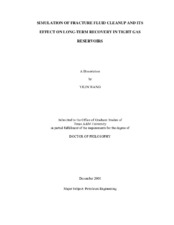| dc.description.abstract | In the coming decades, the world will require additional supplies of natural gas to meet the demand for energy. Tight gas reservoirs can be defined as reservoirs where the formation permeability is so low (< 0.1 md) that advanced stimulation technologies, such as large volume fracture treatments, are required before a reasonable profit can be made. Hydraulic fracturing is one of the best methods to stimulate a tight gas well. Most fracture treatments result in 3-6 fold increases in the productivity index. However, if one computes the effective fracture length of most wells, we usually find that the effective length is less than the designed propped fracture length. The “propped length” is the distance down the fracture from the wellbore where proppants have been placed at a high enough concentration to “prop open” the fracture. The “effective length” is the portion of the propped fracture that cleans up and allows gas flow from the reservoir into the fracture then down the fracture to the wellbore.
Whenever the effective length is much shorter than the designed propped length, several reasons must be evaluated to determine what might have occurred. For example, the difference could be caused by one or more of the following issues: insufficient fracture fluid cleanup, proppant settling, proppant embedment, proppant crushing, or poor reservoir continuity.
Although all these causes are possible, we believe that fracture fluid cleanup issues may be the most common reason the industry fails to achieve the designed propped fracture length in most cases. In this research, we have investigated fracture fluid cleanup problems and developed a better understanding of the issues involved which hopefully will lead to ways to improve cleanup.
Fracture fluid cleanup is a complex problem, that can be influenced by many parameters such as the fluid system used, treatment design, flowback procedures, production strategy, and reservoir conditions. Residual polymer in the fracture can reduce the effective fracture permeability and porosity, reduce the effective fracture half-length, and limit the well productivity. Our ability to mathematically model the fundamental physical processes governing fluid recovery in hydraulic fractures in the past has been limited.
In this research, fracture fluid damage mechanisms have been investigated, and mathematical models and computer codes have been developed to better characterize the cleanup process. The codes have been linked to a 3D, 3-phase simulator to model and quantify the fracture fluid cleanup process and its effect on long-term gas production performances. Then, a comprehensive systematic simulation study has been carried out by varying formation permeability, reservoir pressure, fracture length, fracture conductivity, yield stress, and pressure drawdown. On the basis of simulation results and analyses, new ways to improve fracture fluid cleanup have been provided. This new progress help engineers better understand fracture fluid cleanup, improve fracture treatment design, and increase gas recovery from tight sand reservoirs, which can be extremely important as more tight gas reservoirs are developed around the world. | en |


